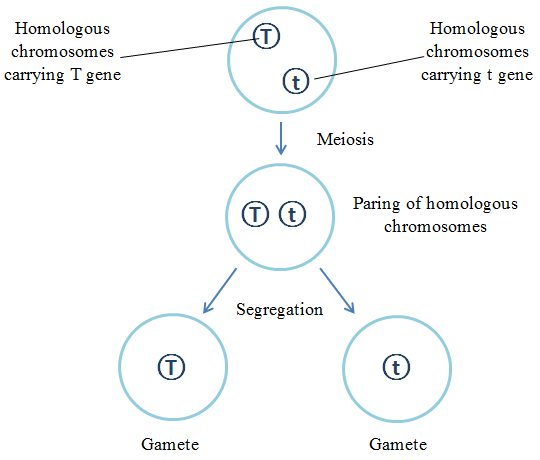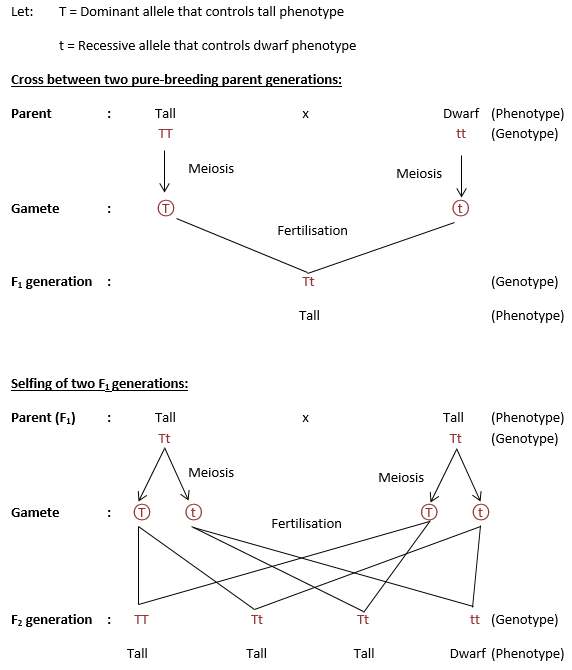Principle of Segregation: Difference between revisions
No edit summary |
|||
| (7 intermediate revisions by one other user not shown) | |||
| Line 1: | Line 1: | ||
=== The Principle of Segregation === | |||
---- | |||
The principle of segregation by [[Gregor Johann Mendel|Gregor Johann Mendel]], also known as '''Mendel's first law '''or '''law of equal segregation '''(Griffiths, Wessler, Carroll & Doebley. 2012, p. 32)<ref>GRIFFITHS, A.J.F., WESSLER, S.R., CARROLL, S.B. and DOEBLEY, J., (2012) Introduction to Genetic Analysis. Tenth ed. New York: W.H. Freeman and Company.</ref>, states that each characteristic of an organism is controlled by two [[Alleles|alleles]] ([[Gene|gene]] occurring in pairs). During [[Gametes|gametes]] formation in [[Meiosis I|meiosis I]], the alleles from each gene will segregate from each other and each gamete will only carry one of the alleles (Hartl & Ruvolo. 2012, p.85)<ref>HARTL, D.L. and RUVOLO, M. (2012) Genetics: Analysis of Genes and Genomes. Eighth ed. Burlington: Jones and Bartlett Learning.</ref>. | |||
[[Image:The Principle of Segregation (diagram).png|The Principle of Segregation]] | |||
=== Significance of the Discovery of Principle of Segregation === | |||
---- | |||
This law of equal segregation allows us to understand single-gene inheritance pattern. It also provides us with an insight as to how traits are being passed down from one generation (parent) to the subsequence generation (offspring). | |||
</ | |||
=== Mendel’s Experiment === | |||
---- | |||
''Main article: '''[[Mendelian inheritance|Mendelian Inheritance]]''''' | |||
In order to have a better grasp on the principle of segregation, we must first understand the experiment carried out by Gregor Mendel that eventually brought to the discovery of this principle. | |||
Mendel began by crossing a pure-breeding ([[True-breeding|true-breeding]]) tall pea plant with another pure-breeding dwarf pea plant (parental generation, P<sub>1</sub> generation). Following the crossed, he noticed that all progenies of the first filial (F<sub>1</sub>) generation grew into tall pea plants.<br>He then crossed a F<sub>1</sub> plant with another F<sub>1</sub> plant ([[Selfing|selfing]]). The intercrossed of two F<sub>1</sub> plants produced second filial (F<sub>2</sub>) generation with two different characteristics. F<sub>2</sub> generation was a mixture of tall and dwarf pea plants. The ratio of tall pea plant to dwarf pea plant was roughly around 3:1 (75% of F<sub>2</sub> generation grew into tall pea plants while 25% of the F<sub>2</sub> generation grew into dwarf pea plant.). | |||
[[Image:Monohybrid Cross (diagram).png|Monohybrid crosses involving alleles controlling the stem length of pea plant that leaded to the discovery of the principle of segregation.]] | |||
=== References<br> === | |||
<references /> | |||
Latest revision as of 06:08, 19 October 2015
The Principle of Segregation
The principle of segregation by Gregor Johann Mendel, also known as Mendel's first law or law of equal segregation (Griffiths, Wessler, Carroll & Doebley. 2012, p. 32)[1], states that each characteristic of an organism is controlled by two alleles (gene occurring in pairs). During gametes formation in meiosis I, the alleles from each gene will segregate from each other and each gamete will only carry one of the alleles (Hartl & Ruvolo. 2012, p.85)[2].
Significance of the Discovery of Principle of Segregation
This law of equal segregation allows us to understand single-gene inheritance pattern. It also provides us with an insight as to how traits are being passed down from one generation (parent) to the subsequence generation (offspring).
Mendel’s Experiment
Main article: Mendelian Inheritance
In order to have a better grasp on the principle of segregation, we must first understand the experiment carried out by Gregor Mendel that eventually brought to the discovery of this principle.
Mendel began by crossing a pure-breeding (true-breeding) tall pea plant with another pure-breeding dwarf pea plant (parental generation, P1 generation). Following the crossed, he noticed that all progenies of the first filial (F1) generation grew into tall pea plants.
He then crossed a F1 plant with another F1 plant (selfing). The intercrossed of two F1 plants produced second filial (F2) generation with two different characteristics. F2 generation was a mixture of tall and dwarf pea plants. The ratio of tall pea plant to dwarf pea plant was roughly around 3:1 (75% of F2 generation grew into tall pea plants while 25% of the F2 generation grew into dwarf pea plant.).

